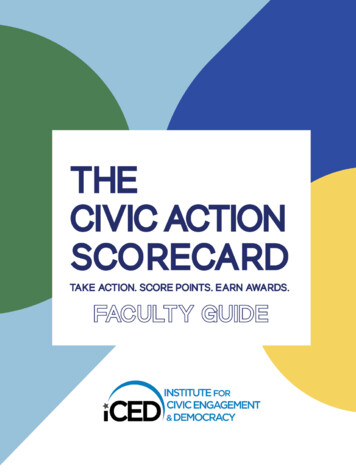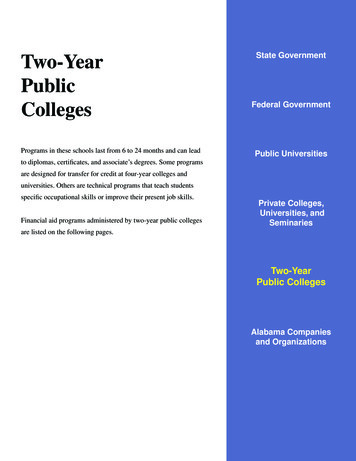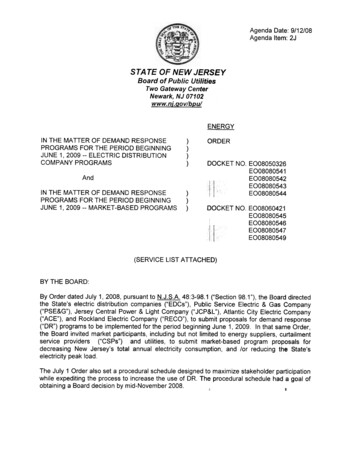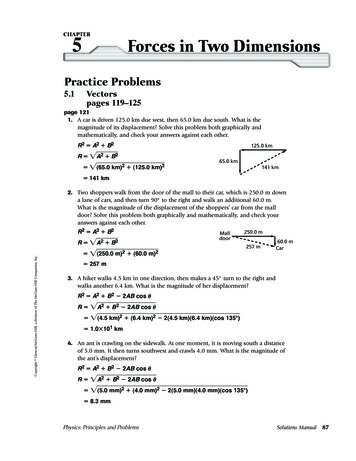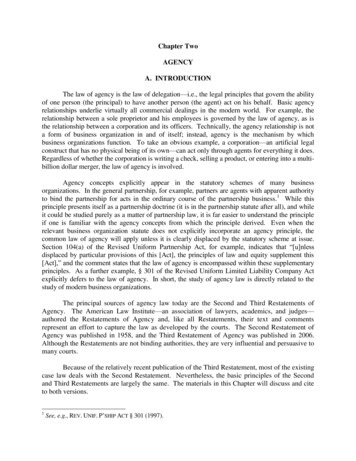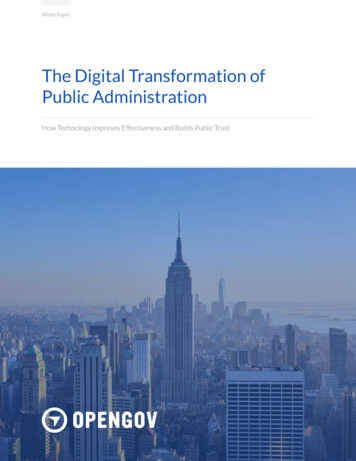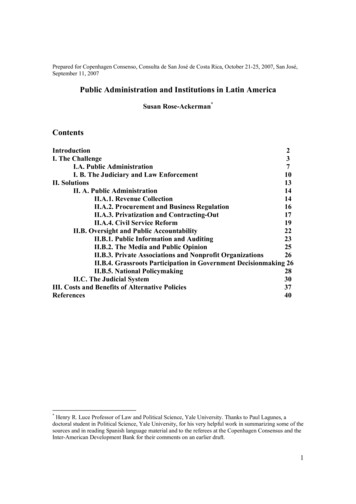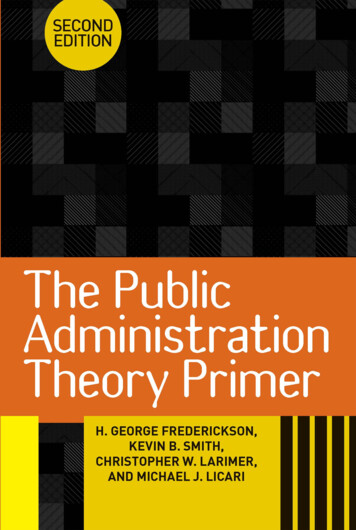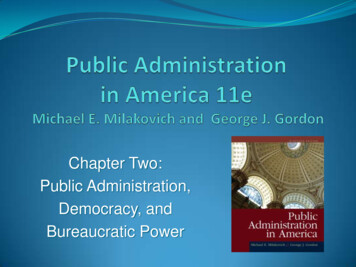
Transcription
Chapter Two:Public Administration,Democracy, andBureaucratic Power
Public Administration, Democracy,and Bureaucratic Power The governmental system is continuouslyreshaped by society’s values and beliefs
Political andAdministrative Values Fundamental beliefs underlyinggovernment and public bureaucracy Values impact public administration Conflicting values affects conduct ofpolitics and administration
Political andAdministrative Values Liberal democracy (political system) Popular sovereignty Limited government Capitalist (economic system) Means of production owned by privatecitizens
Political andAdministrative Values Representation Legislative selection that providesdemographic representativeness Public discontent with system has grown inrecent years Disputed issues include affirmative action,immigration policy, government spending,preferential hiring
Political andAdministrative Values Limited Government Checks and balances Separation of powers Federalism Judicial review
Political andAdministrative Values Individualism Belief in the worth and dignity of the individual Pluralism Stresses group organization as means ofsecuring protection for broad interests Groups have right to organize, pursue interests Resulting compromises benefit all
Political andAdministrative Values Values how things are accomplishedmore than what is accomplished Due process of law But gap between ideal/operational reality
Representative Democracy Representatives nominated andelected from individual districts Legislature makes binding decisions Majority rule AND minority rights Requires widespread involvement in process
Direct Participation in Democracy Participatory democracy Direct involvement by citizens in processesof governmental decision making Changes thinking about democracy andway some government decisions made
Administrative Values, Pluralism,and Political Accountability Politics and administration previouslyseen as separate and distinct Pre-20th century: politically neutral/passive “Science of administration” view inresponse to widespread corruption Efforts to separate politics andadministration continue thru mid-century
Administrative Values, Pluralism,and Political Accountability Problems with separation of politicsand administration Approaches not all consistent with politicalvalues articulated by the Constitution Protections have created possibility ofadministrative excesses Conflict between Constitution andadministrative values Unchecked power vs. problem solving/efficiency
Pluralist Democracy vs.Administrative EfficiencyPluralist Democracy Power dispersed anddivided Suspicion of executivepower Politicians, interest groupsand citizens have power Political bargaining okay Emphasis on privateinterestsAdministrative Efficiency Power concentrated andcentralized Emphasis on chiefexecutive (accountability) Experts and professionalbureaucrats have power Avoid politics Emphasis on technicaland scientific reasoning
Political Accountability Political participation and equality ofopportunity 1700s voting, holding office (limited bywealth, social status, race, gender, etc.) 1830s political eligibility begins to broaden Modern all citizens eligible, can be involved Today mandatory inclusion issues
Democracy and PublicAdministration Democracy requires mechanisms forboth participation and accountability Public administration poses problemsfor such a system Bureaucratic accountability has to beachieved through indirect popular influence Conflict between competence and citizenparticipation
Freedom of Information andSunshine Laws Sunshine laws Increases public’s ability to inquire intoactivities of bureaucracy and government Sunset laws Requires positive legislative action to renewagency mandates
Freedom of Information andSunshine Laws Freedom of Information Act (FOIA) Enables private citizens to gain access tovariety of government records and files Breaks down bureaucratic secrecy U.S. v. Landano WikiLeaks
Freedom of Information andSunshine Laws Legislation at the national level Freedom of Information Act Fair Credit Reporting Act Family Educational Rights and Privacy Act Privacy Act of 1974 Fair Credit Billing Act Bureau of Consumer Protection (BCP)
Dimensions of DemocraticAdministration Challenges for democratic norms: Citizen participation Bureaucratic representativeness Bureaucratic responsiveness Administrative effectiveness (possiblethreat to personal freedom)
Citizen Participation Roots in participatory democracy Reborn in civil rights movement Decentralization of urban governments Many forms: advisory or coproducers ofservices Reduces citizen alienation from government Centralization vs. decentralization Programs used to increase participation Community control Public interest groups (PIGs)
Citizen Participation Who is to participate and to whatextent has important implications Possibility that citizen participation willbe co-optation and tokenism Decentralizing and localizing controlover governmental programs may notguarantee increased participation
Citizen Participation Citizen participation has mixed recordof success Tension between citizens andgovernment Citizen input Coproduction, empowerment, partnership,and full control
Bureaucratic Representativeness Delegate role Constituents’ opinions and preferencesreflected in legislative voting Trustee role Representatives exercise independentjudgment and individual conscience
Bureaucratic Representativeness“The attainment of the democratic ideal inthe world of administration depends muchless on majority votes than on theinclusiveness of the representation ofinterests in the interaction process amongdecision makers.”
Bureaucratic Representativeness Delegation of authority The people give authority to Congress andlegislatures Legislatures give authority to bureaucracies Discretionary authority may diminish therepresentational quality of decisions
Bureaucratic Representativeness Women, gays, and ethnic minorities,believe greater representativeness isneeded Evangelical FundamentalistChristians, Neo-Conservatives, andthe Tea Party take similar stances
Bureaucratic Responsiveness Depends on assumptions about what isand what should be in the conduct ofgovernment and public-policy making Requires meaningful access to the rightdecision makers Government must be able to respond toemergencies and policy demands in newways to meet new threats.
Bureaucratic Responsiveness Constraints Ideally, public expectations should berealistic, reasonable, and manageable Government agencies cannot—or do not—respond equally to all societal interests
Administrative Effectiveness andPersonal Liberty Dilution of individual liberties Does not necessarily occurdeliberately USA PATRIOT Act
The Political Environment ofBureaucratic Power Lack of centralization Competition for power Constrains and creates opportunities forstakeholders Lack of cohesive political majorities withinthe two houses Lack of clarity in legislative mandates togovernment agencies of Congress
The Political Environment ofBureaucratic Power Legislative oversight Legitimate function of Congress Results in strict control by a legislativecommittee or subcommittee Definitions of agency power notequivalent to actual power Agencies’ power influenced byrelationships with other political actorsand institutions
The Political Environment ofBureaucratic Power Jurisdiction Bureaucratic imperialism Interest groups Institutions act as unified entities andarenas of political competition
Bureaucratic Expertiseand Political Support Bureaucratic experts acquire increasinginfluence because of specializedknowledge Full-time attention to a problem Specialization in the subject Monopoly on information Pattern of increasing reliance for technicaladvice Use of specialized language
Bureaucratic Expertiseand Political Support To gain legislative support, agenciesmust Respond promptly to requests forinformation Effectively promote and manage programs Cooperate administratively with legislators’electoral needs Anticipate legislative preferences regardingthe operations of particular programs
Bureaucratic Expertiseand Political Support Executive Support Decisive in determining success or failure Office of Management and Budget (OMB) Interagency alliances
Bureaucratic Expertiseand Political Support Clientele groups Depend on the agency for satisfaction oftheir policy demands Trade expertise for political resources General public Public opinion can tilt the political balanceof power
Subsystem Politics in America Parallels between nationalgovernment, bureaucracy andCongress Division of labor Congress and the bureaucracy areorganized primarily according to function Specialized nature of smaller units
Subsystem Politics in America Large institutions defer to specializedunits Misleading to assume influence concentratedonly “at the top” Bureaucratic expertise is a source ofbureaucratic power Legislators attracted to committees in whichthey can have the most impact in policy areasthat interest them
Interest Groups and“Iron Triangles” Pooling of political resources createssubsystems (iron triangles) Members have influence in the policy-making process Combine the benefits of bureaucraticexpertise, congressional leverage,and interest group capabilities
Interest Groups and“Iron Triangles”Source: Randall B. Ripley and Grace A. Franklin, Congress, the Bureaucracy, and Public Policy, 5th ed. (PacificGrove, Calif.: Brooks/Cole, 1991), p.102.
Interest Groups and“Iron Triangles” Subsystem activity tends to remainbehind the scenes Quiet cooperation Bills may be referred to multiplecommittees (multiple referral) Joint, sequential or split
Interest Groups and“Iron Triangles” Weakening of subsystems Gridlock Partisanship Members of Congress subject to strongerpressures to respond to party rather thancommittee leaders
“Issue Networks” Similar to subsystems Open and fluid groupings ofindividuals both inside and outside ofgovernment Exist when policy question emergesthat activates wide range of interests
Bureaucratic Power andPolitical Accountability Enforced through multiple channels,legislative and executive Difficulties Authority delegated by both chief executiveand legislative branch Inability of executives to commandwholehearted responses from subordinates
Bureaucratic Power andPolitical Accountability Bureaucratic accountability Political entities not beyond control of otherentities in a checks-and-balances system Entities have responsibility to adhere tobroad will of the governed
Instruments of ControlPresidentCongress Powers of appointment Appropriations power Government and dismissalInitiative in lawmakingExecutive Office of thePresident (EOP)Financial leverageMass mediaBureaucraticrestructuringLine-item vetoAccountability Office(GAO) Hearings beforecongressionalcommittees Other devices
Bureaucratic Power andPolitical Accountability Responsibility for legislative oversightpassed from full committees tosubcommittees Congress more dependent on agencies andinterest groups Less inclined to “challenge the existingrelationships between agencies and interestgroups”
Bureaucratic Power andPolitical Accountability Accountability hampered byprevalence of technical subject matter Competing criteria for decisions Bureaucratic agencies held to accountby mass media Internet revolution
Administrative Discretion andPolitical Accountability Administrative discretion has one verypositive aspect Program managers better in makingdecisions about the broader public interest Interference with administrativediscretion brings about narrowresponsiveness to private interests
Public Administration, Democracy, and Bureaucratic Power. The governmental system is continuously reshaped by society’s values and beliefs. Political and Administrative Values. Fundamental beliefs underlying government and public bureaucracy. Values impact public administration.File Size: 1MBPage Count: 49
